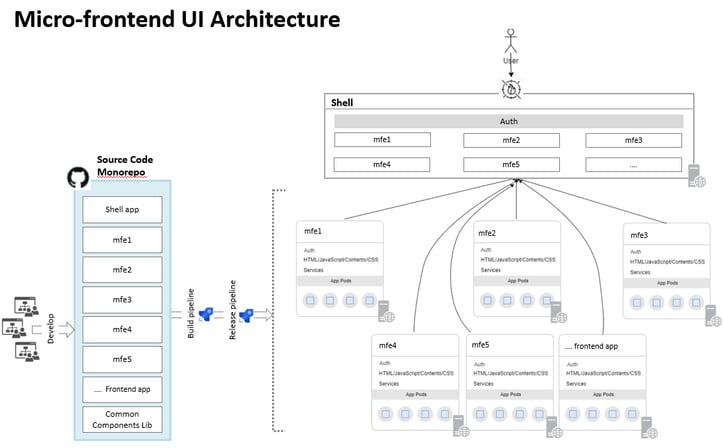Introduction
Micro-frontends have emerged as a powerful architectural pattern for building complex web applications. By breaking monolithic frontends into smaller, independent services, we can achieve greater scalability, maintainability, and development velocity. In this blog, we'll delve into the core concepts, technical implementation, and best practices of micro-frontends.
Imagine a large, complex front-end application. It's like a monolithic building, difficult to maintain, scale, and update. Now imagine breaking that building down into smaller, independent units, each with a team and development process. That's the essence of micro-frontends.
Core Concepts
The three fundamental principles of micro-frontends are independent development, loose coupling, and technology agnosticism. These principles allow us to build modular, scalable, and flexible applications.
Each unit is a self-contained component with micro-frontends that can be developed, tested, and deployed independently. This means faster development cycles, reduced risk, and greater technology flexibility.
Implementation Strategies
One way to implement micro-frontends is through server-side composition. The server assembles the micro-frontends into a single page.
Another approach is client-side composition, where micro-frontends are loaded dynamically on the client.
Best Practices
Aligning micro-frontends with business domains, maintaining a consistent user experience, and optimizing performance are important to ensuring a successful micro-frontend architecture.
The micro-frontend approach offers several advantages:
Reduced risk: By releasing modules individually, you can mitigate the risk of deploying a new system with bugs or other issues. If there is a problem with a particular module, you can easily roll back to the previous version without affecting the entire system.
Faster time to market: Releasing modules incrementally allows you to get new features and functionality to users sooner. This can be especially beneficial if you are pressured to meet a deadline.
Improved maintainability: Micro frontends are easier to maintain and update than a monolithic UI. Each module is independent and can be developed and deployed separately.
Flexibility: You can easily experiment with different UI technologies and frameworks by developing micro frontends in other languages or using various libraries.

Micro-frontend Architecture with Mono-repo
Micro-frontends are independently deployable units that make up a larger application. They offer benefits like scalability, maintainability, and team autonomy.
Monorepo is a single repository that houses the code for all micro-frontends. It provides centralized management, code sharing, and streamlined workflows.
Benefits:
- Smaller, easier-to-manage pieces: Micro-frontends make working on and understanding the project easier.
- Flexibility: Each microfrontend can use the best tools for the job.
- Faster updates: Changes can be made and released quickly for individual micro-frontends.
- Shared resources: A monorepo makes sharing code and tools between micro-frontends easy.
- Improved performance: Micro-frontends can be optimized to load and render more efficiently,
The key is to find the right balance. By breaking down the project into smaller pieces (micro-frontends) and keeping them organized in one place (mono repo), you can create a more efficient and effective development process.
Get Started with Micro-frontends
The MFE-starter-kit project provides a starting point for building a micro-frontend architecture using Nx, a powerful tool for managing monorepos (codebases with multiple projects).
Key Features:
- Microfrontend Architecture: The project leverages @angular-architects/native-federation to implement a microfrontend approach, enabling you to build independent frontend modules that can be combined into a cohesive application.
- Modern UI Components: Kendo UI for Angular is pre-integrated, offering a rich set of UI components to enhance your application's user experience.
- Authentication and Authorization: The Okta Angular SDK allows you to integrate secure authentication and authorization functionalities into your micro-frontends easily.
- Dynamic Layouts: The project offers support for dynamic layouts, enabling you to design flexible UI structures.
Ready to Build?
Refer to the mfe-starter-kit’s README (https://github.com/bbpcoforge/mfe-starter-kit) for detailed instructions on creating a new project and leveraging these features to build your micro-frontend application.






